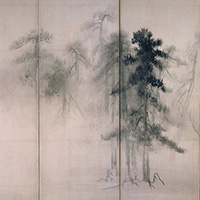国宝 松林図屏風
-

国宝 松林図屏風(部分) 長谷川等伯筆 安土桃山時代・16世紀
本館 2室
2017年1月2日(月) ~ 2017年1月15日(日)白い和紙の上に墨の濃淡だけで、風と光の情景が生み出されています。画面に近づいて松の葉をみると、その激しい筆勢に押されて、後ずさりするくらいです。松を描く筆は、穂先をいくつも重ねたもの、竹の先を細かく砕いたもの、あるいは藁(わら)を束ねたものを使ったと考えられており、明らかではありません。繊細でありながら迷いなく筆を進め、一気に線を引いていることが見てとれます。離れてみると、松の幹はまるで能を舞うかのように風に揺られています。
四つほどの大きなグループに描かれた松林は、木々の間を風が通り抜けるように配置されています。そして、墨のグラデーションによって光の強弱をあらわして、霧に包まれた松林を生み出しているのです。
さまざまな工夫と技法によってあらわされたこの松林には、霧の晴れ間から柔らかな光が差し込んで、遠く雪山がのぞき、冷たく湿った空気が漂います。艶(つや)やかな墨の色と相まって、風の流れや森の清清しい香りまで実感できるでしょう。
等伯は松林という日本の伝統的なモティーフを、中国絵画から学んだ水墨表現によって描き出し、日本の風土の豊かな形象をみごとにあらわしているのです。
| 指定 | 名称 | 員数 | 作者・出土・伝来 | 時代・年代世紀 | 所蔵者・寄贈者・列品番号 | 備考 | |
| おすすめ | 国宝 | 松林図屏風 | 6曲1双 | 長谷川等伯筆 | 安土桃山時代・16世紀 | A-10471 |
